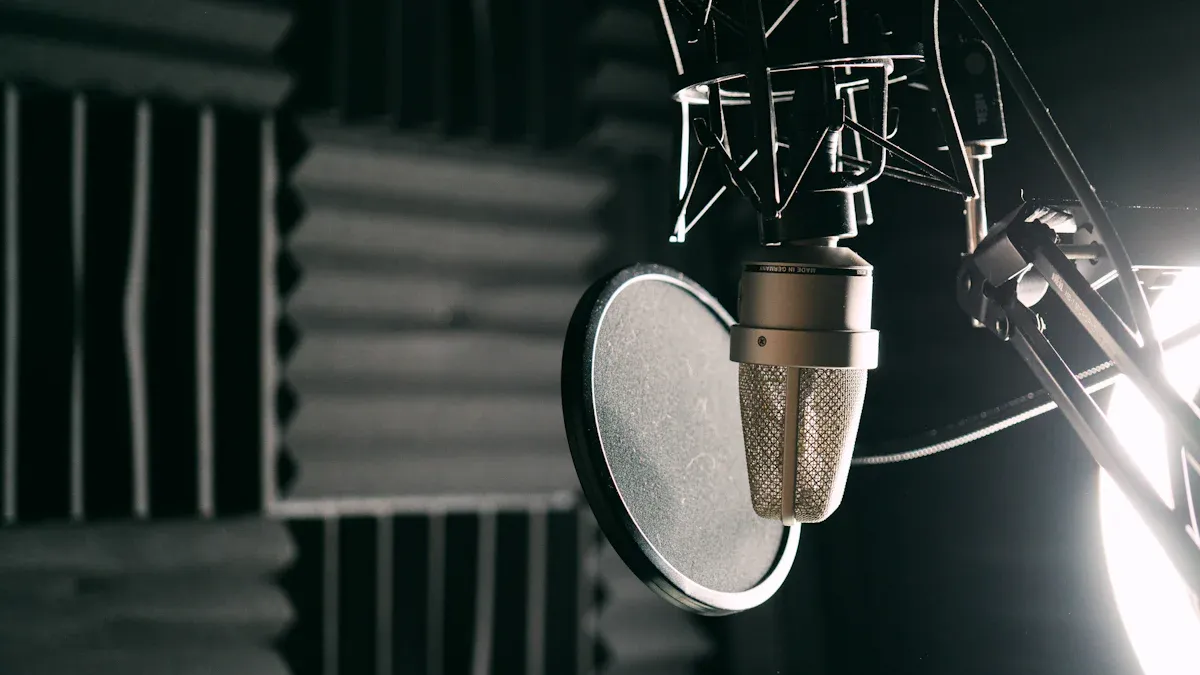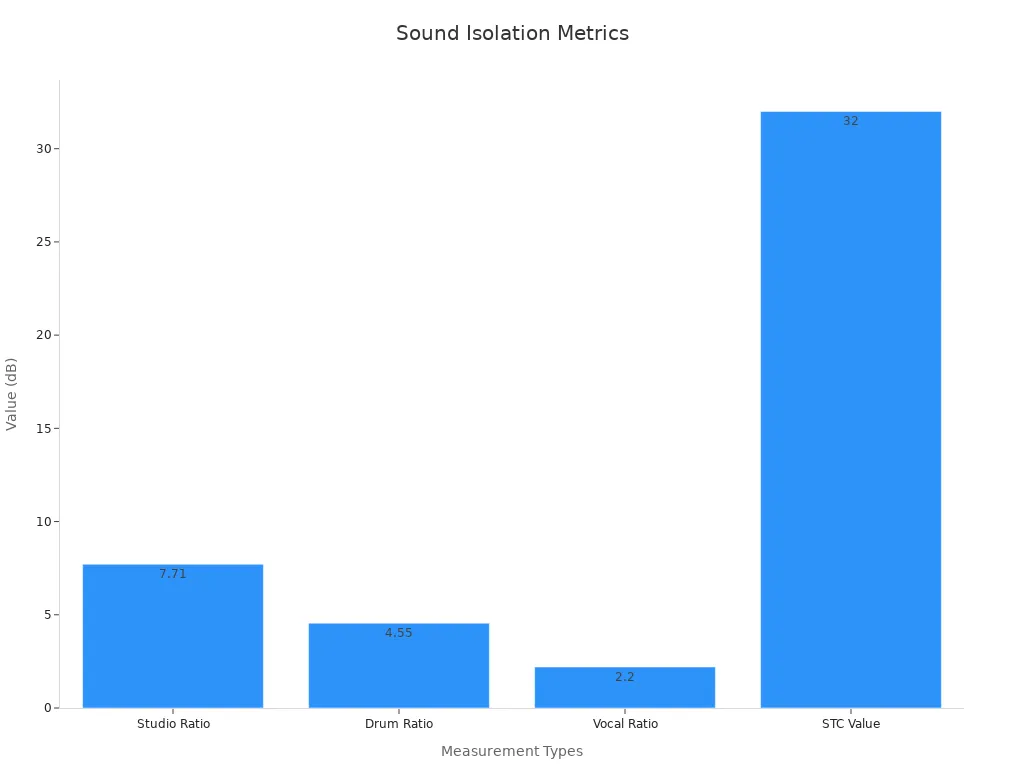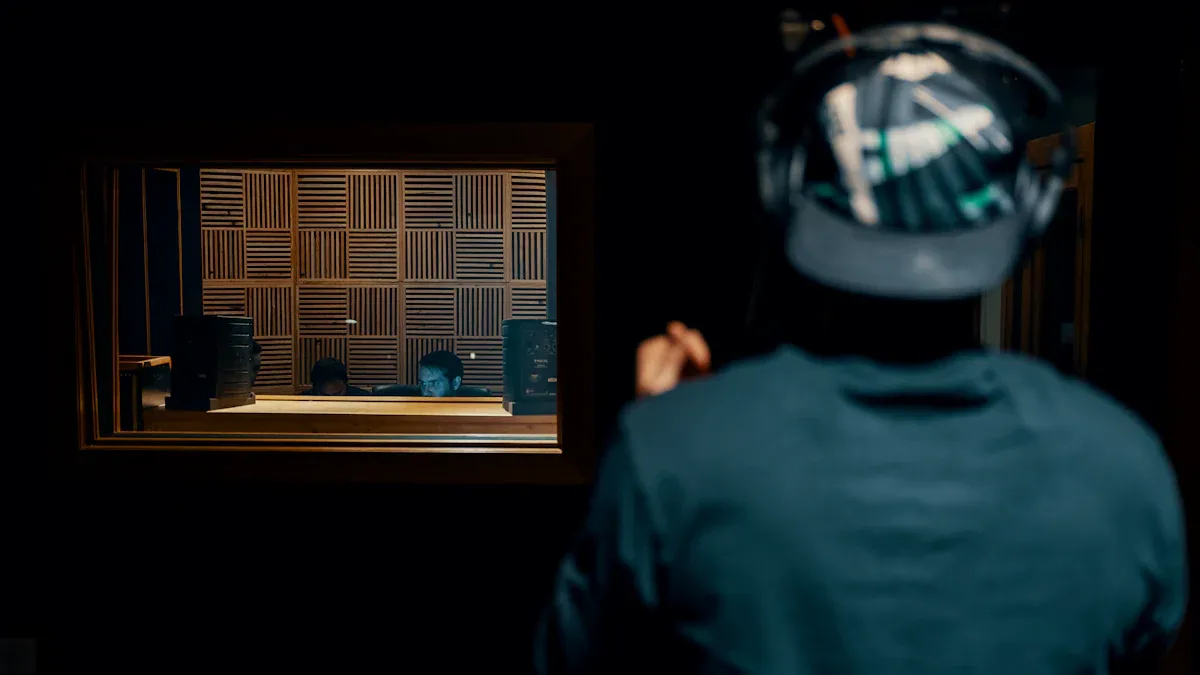A soundproof studio booth delivers strong sound isolation, often using advanced materials like double-layer laminated glass and carbon plastic boards. Many users choose phone booth office pods or soundproof office pods for their 25±3 dB A-Class soundproofing, portable office booth designs, and compliance with ISO 23351-1:2020 for privacy.
Pros of a Soundproof Studio Booth

Effective Sound Isolation
A soundproof studio booth provides outstanding sound isolation, making it a top choice for professionals who need a quiet environment. High-density materials and precise construction block unwanted noise from entering or leaving the booth. This isolation allows users to focus on their work without distractions from outside sounds.
Note: Many booths use advanced sound-absorbing materials like acoustic foam, which help eliminate echo and reduce background noise. Proper ventilation systems keep the air fresh and comfortable without letting in noise.
The effectiveness of sound isolation can be measured using several engineering metrics:
| Measurement Type | Values / Description |
|---|---|
| RT60 Decay Times | 0.05 to 0.14 seconds, showing rapid sound decay and strong isolation |
| Direct-to-Reverberant Energy Ratio | 2.2 dB to 13.1 dB, depending on booth setup, showing control over reflections |
| Sound Transmission Coefficient (STC) | 32 dB for a freestanding isolation booth, indicating significant sound transmission loss |
| Early Decay Rates | As low as 0.05 sec with correct setup, showing very quick sound decay |

These measurements show that a soundproof studio booth can create an environment with minimal echo and strong control over sound reflections.
Improved Recording Quality
A soundproof studio booth improves recording quality by reducing the impact of room acoustics and background noise. In laboratory tests, researchers compared voice recordings made in a soundproof booth to those made in regular rooms. They found that key voice parameters, such as Jitter and cepstral peak prominence (CPPS), remained stable and reliable in the booth. This means that the booth helps capture clear, consistent audio, which is important for professional results.
Consistent recording quality helps musicians, podcasters, and voice-over artists produce work that meets industry standards.
Portability and Flexibility
Modern soundproof studio booths offer both portability and flexibility. Many models use modular designs, allowing users to adjust the size or move the booth as needed. This flexibility supports dynamic workspaces and changing needs.
| Feature Aspect | Mobile Soundproof Booths | Stationary Soundproof Booths | Usage Environments |
|---|---|---|---|
| Portability | Portable, compact, lightweight; easy relocation and quick setup | Fixed installation; not portable | Recording studios, offices, meeting rooms, educational and healthcare facilities, coworking spaces |
| Durability | Modular and flexible; designed for adaptability | Built for long-term use; robust features | Environments demanding high acoustic isolation and comfort |
| Market Trends | Growing demand for hybrid work and adaptable booths | Preferred for permanent setups | Open-office layouts, remote workspaces, corporate offices, educational institutions |
Tip: Modular booths can be resized or relocated, making them ideal for businesses or individuals who may need to move or reconfigure their workspace.
Professional Appearance
A soundproof studio booth adds a professional look to any environment. Manufacturers use premium materials and precise fitting to create a sleek, modern design. This appearance not only impresses clients and visitors but also helps users feel confident and focused during recording sessions.
- The global market for soundproof booths is growing, driven by demand in recording studios, broadcasting, and other sectors that require quiet, professional spaces.
- Customization options and ergonomic designs allow users to match the booth to their brand or workspace.
- Technological features, such as noise cancellation and smart monitoring, further enhance the professional experience.
A soundproof studio booth signals a commitment to quality and professionalism, making it a valuable addition to any creative or business setting.
Cons of a Soundproof Studio Booth
High Cost
The financial investment for a soundproof studio booth can be significant. Many professionally installed soundproof rooms cost several thousand to tens of thousands of dollars. This price point often exceeds what small businesses or individuals can afford. The U.S. Census Bureau’s 2021 American Housing Survey shows that the median household income was $71,186, making these costs a major consideration for most families and small companies.
A breakdown of soundproofing costs highlights the range of expenses:
| Area Size (sq ft) | Low-End DIY ($) | High-End Professional ($) | Cost per sq ft (Residential) | Cost per sq ft (Commercial) |
|---|---|---|---|---|
| 200 | 330 | 880 | $1.65–$4.40 | $2.20–$6.60 |
| 400 | 660 | 1,760 | $1.65–$4.40 | $2.20–$6.60 |
| 1,000 | 1,650 | 4,950 | $1.65–$4.40 | $2.20–$6.60 |
Professional installation can increase costs by 20% to 60%. Additional expenses include permits, acoustic treatments, and ongoing maintenance. About 35% of small businesses report that the high upfront cost of purchasing and installing a soundproof studio booth is a significant barrier. Price increases in materials, such as foam and soundproofing components, have also contributed to rising costs.
Many companies and individuals find that the initial investment, plus ongoing maintenance, limits their ability to install a soundproof studio booth.
Space Requirements
Space is another important factor when considering a soundproof studio booth. Urban dwellings and offices often have limited square footage, making it difficult to dedicate space for a booth. The average size of new single-family houses in the U.S. was 2,261 sq. ft. in 2020, but many urban homes and offices are much smaller.
- Professionally installed soundproof rooms require a dedicated area, which may not be available in smaller spaces.
- Soundproof pods typically occupy less than 50 sq. ft. and seat 1–4 people, but even this can be a challenge in compact environments.
- Open-plan offices usually allocate 150–250 sq. ft. per employee, so adding a booth requires careful planning.
- A 2023 workplace survey found that 70% of U.S. companies use open-plan offices, and 78% of facilities managers consider visual coherence with the workspace when selecting soundproof booths.
Space constraints, especially in urban areas, limit the feasibility of installing a soundproof studio booth.
Assembly and Maintenance
Setting up a soundproof studio booth involves careful planning and attention to detail. Installation often requires collaboration with acousticians to avoid acoustic conflicts. Contractors may need to modify HVAC systems, install vibration-dampening mounts, and use sound blankets to reduce noise from equipment.
Regular maintenance is necessary to keep the booth functioning well. For example, users with multi-stage HEPA air filters in their booths vacuum the intake filter regularly and replace the main filter annually. Cleaning schedules and filter changes help maintain air quality and quiet operation. Although modular pods require 72% less annual maintenance than permanent structures, upkeep remains an ongoing responsibility.
Proper assembly and regular maintenance are essential for long-term performance and reliability.
Sound Coloration
A soundproof studio booth can change the way audio sounds inside the space. Engineering studies and audio tests show that traditional vocal booths sometimes create a “dead” sound, causing sensory deprivation and coloration. This effect can limit the natural quality of recordings.
The AES paper “Sound Fusion and the Acoustic Presence Effect” explains that early coherent reflections and diffuse reflections help create a stable acoustic space. Newer designs, such as the QuickSoundField (QSF) method, add early reflections within 50 milliseconds to reduce coloration and echo detection. These improvements help produce voice recordings that closely match those made in open environments, but some coloration may still occur in traditional booths.
Audio engineers and talent often notice differences in sound quality when recording in a booth compared to a larger room. Advanced booth designs can reduce these effects, but users should remain aware of potential changes in sound.
Real User Experiences with Soundproof Studio Booths

Positive Feedback from Users
Many users report strong satisfaction with their soundproof studio booth experiences.
- People value the clear and crisp sound these booths provide.
- The need for high-quality recording spaces has grown as urban noise increases.
- Customization options help users match booths to their specific needs, which boosts satisfaction.
- Technological improvements, such as AI design tools, make booths more efficient and user-friendly.
- Users often mention that the professional environment and expert support in commercial studios help them stay focused and creative.
- Low noise floors, sometimes as quiet as 30dB, allow for distraction-free work.
Common Complaints and Limitations
Some users share concerns about space and setup.
- Limited space in homes or offices can make booth placement difficult.
- Users sometimes notice changes in sound quality, especially if the booth is not set up correctly.
- A few people mention that small booths can feel cramped during long sessions.
- Some users find that reflective noise from parallel walls affects recordings if they do not position themselves carefully.
Practical Tips and Lessons Learned
Experienced users offer helpful advice for getting the best results.
- Avoid typing during recording to keep background noise low; use pen and paper instead.
- Position yourself at an angle to booth walls to reduce echo.
- Walk-in closets with clothing can serve as good sound-absorbing spaces if a booth is not available.
- Removable foam wedges or baffles improve acoustics inside the booth.
- Use a cardioid microphone with the rear facing reflective surfaces to cut down on unwanted noise.
- Keep a fist’s distance from the microphone and use pop filters to avoid plosive sounds.
- Post-production tools like EQ and noise reduction software help clean up any remaining issues.
Factors to Consider Before Buying a Soundproof Studio Booth
Budget and Value for Money
Buyers should evaluate both the initial investment and long-term value. Several factors influence the price of a soundproof studio booth:
- Size and capacity: Larger booths cost more but offer more space.
- Soundproofing and acoustics: High-quality materials increase price but improve privacy and performance.
- Materials and design: Premium woods, metals, and eco-friendly options raise costs but add durability.
- Technology features: Smart lighting, ventilation, and power outlets add to both cost and convenience.
- Brand and warranty: Well-known brands often charge more but may offer better support.
- External cost factors: Labor and shipping costs can affect the final price.
Tip: Buyers should compare features and warranties to ensure the booth meets their needs and budget.
Space and Placement
Space planning plays a key role in booth selection. Market research shows that booth size and portability matter for different environments. Experts recommend measuring available space and considering future needs. The table below shows sample booth dimensions and features:
| Feature | VocalBoothToGo SPB Series | SilentBoxPro Drums Booth | SilentBoxPro Soundproof Box |
|---|---|---|---|
| Noise Reduction (NRC) | STC 30 (±5 dB) | STC 30 (±5 dB) | STC 30 (±5 dB) |
| Internal Dimensions | Varies by model | W95.47″ x D93.74″ x H85.43″ | W56.89″ x D47.56″ x H85.43″ |
| External Dimensions | Varies by model | W100.59″ x D97.24″ x H90.55″ | W62.01″ x D50.98″ x H90.55″ |
| Ventilation | Built-in ventilation | Exhaust fan included | Exhaust fan included |
| Lighting | LED lighting included | LED 3000K lighting | LED 3000K lighting |
Experts suggest placing booths away from corners and walls to reduce unwanted echoes and improve sound quality.
Intended Use and Frequency
The intended use shapes the choice of booth. Musicians, podcasters, voice actors, and content creators all have different needs. Frequent users may prefer larger, more durable booths with advanced features. Occasional users might choose compact or portable models. Key features like soundproofing, ease of assembly, and acoustic treatment should match the user’s main activities.
Alternatives to Soundproof Studio Booths
Some buyers may consider alternatives. Options include:
- Portable acoustic panels
- DIY vocal shields
- Using closets or small rooms with added sound-absorbing materials
- Renting professional studio time
These alternatives may suit those with limited budgets or space, but they often provide less isolation and flexibility than a dedicated soundproof studio booth.
Experts agree that portable vocal booths reduce room reflections above 500 Hz, but low-frequency noise remains a challenge. Users should compare models for attenuation and coloration. The table below highlights key differences:
| Model | Attenuation | Coloration | Price Range |
|---|---|---|---|
| Reflexion Filter Pro | High | Moderate | $249 |
| Real Traps | Highest | High | $299.99 |
| Kaotica Eyeball | Low | Low | $199.99 |
FAQ
How much noise can a soundproof studio booth block?
Most soundproof studio booths reduce outside noise by 25–35 dB. This level creates a quiet space for recording or meetings.
Can users move a soundproof studio booth after installation?
Yes. Many modern booths use modular designs. Users can disassemble and relocate them as needed.
What maintenance does a soundproof studio booth require?
Regular cleaning and filter changes keep the booth fresh. Users should check ventilation systems and replace filters yearly for best performance.

